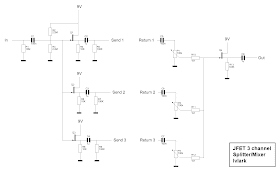Here's a more unusual effect. Playing chords it has a ring mod-ish quality to it, but played higher up the fretboard and using the neck pick up with tone control down gives a very prominent octave effect which sounds great. You'll notice I shared holes for the diodes and a couple of the resistors, this was just to keep the final width down so it will comfortably fit in a 1590B box. It should be easy enough to do unless you're using components with very thick leads. The resistors I used are Dale metal film and are quite thick but I still managed it fine in my build. I'd recommend socketing the transistors and diodes because you can get slightly different sounds by swapping them, Q2 is the transistor to experiment with and try germanium and silicon diodes to see which you prefer.
It is recommended that for the clearest octave effect you match the diodes as closely as possible for forward voltage, and some people have suggested that it is also worth matching the 47nF caps and the 10K and 22K resistors, although if you use 1% metal film they're probably going to be extremely close anyway.
The layout is verified.
Merry Christmas and a Happy New Year to everyone!














































